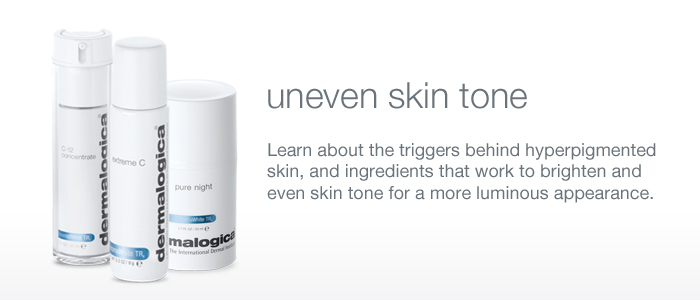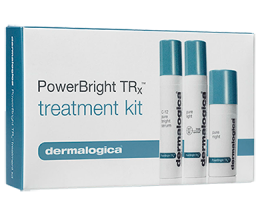Uneven Skin Tone

C-12 Pure Bright Serum
50 ml – $130.50

Daily Microfoliant
75 g – $76.00

MultiVitamin Power Recovery Masque
75 ml – $69.00

PowerBright TRx Kit
Each – $55.00

Pure Night
50 ml – $107.50

Total Eye Care SPF15
15 ml – $69.00
Overview
Research indicates that age spots contribute to the appearance of skin aging as much as a wrinkle. Learn about the triggers behind hyperpigmented skin, and ingredients that work to brighten and even skin tone for a more luminous appearance – and healthier skin.
Hyperpigmentation shows on skin in the form of brown spots (also referred to as age spots) and can cause an uneven, mottled skin tone. Hyperpigmentation can be the result of daylight exposure, endocrine (hormonal) factors and changes, usage of prescription drugs and/or wound healing when skin has been damaged.
How It Works
Causes of Hyperpigmentation: UV Exposure
In addition to the development of an overall tan, exposure to UV light may also stimulate hyperpigmentation in specific spots on the hands, face and neck. These dark spots are often referred to as age spots or liver spots (lentigines), usually become evident in our early forties, and become increasingly more evident as we age. By the time we reach 60 years old, 90% of all individuals will have sun-induced age spots, known as lentigines.
These spots, more than anything else, give away a person’s age. Age spots are caused by skin’s continued exposure to the sun over many years, and unlike freckles, they do not fade in winter. (Freckles, also known as ephilides, are flat spots that are red or brown, typically appear during the summer months and fade in winter. They are most often found in individuals with fair skin and are generally a genetic trait.)
Causes of Hyperpigmentation: Post-Inflammatory Hyperpigmentation
In addition to genetics and environmental influences, skin pigmentation is effected by endocrine (hormonal) factors, usage of prescription drugs, stress, topically-applied products including cosmetics, and wound healing to the skin tissue. The latter incidence gives rise to post-inflammatory hyperpigmentation (PIH), a phenomenon that is more problematic for individuals with darker skin color. PIH stems from the melanocytes exaggerated response to injury, however slight, which results in an increased or abnormal distribution of melanin in the tissues.
Causes of Hyperpigmentation: Melasma
Hormonally induced pigmentation manifests itself in various forms, such as hyperpigmentation spots and melasma, better known as the mask of pregnancy. Melasma affects primarily women of child-bearing age. Some studies suggest that up to 75% of women may develop melasma during pregnancy and about 33% of women on birth control pills also complain of this problem. It is more prevalent in women with darker skin color and it is most commonly seen in areas that are exposed to sunlight.
Some scientists say UV exposure seems to be a requirement for melasma to develop, which may account for the fact that it is less noticeable in winter months when UV exposure is lower. The most common pattern for melisma is centrofacial: on the chin, upper lip, cheeks, nose, and forehead. To a lesser extent, melasma is seen on the cheeks and nose, or on the jawline.
The condition may persist up to 5 years after pregnancy or stopping of birth control pills. Unfortunately, once melasma manifests in skin, chances of having it again increase.
